Incubators and Brooders
Incubators and Brooders
Introduction
Natural incubation by the female bird is the simplest way of hatching eggs. To hatch a large number of eggs you can use a small incubator which is heated by kerosene (paraffin) or electricity. The condition of the eggs in the incubator can be checked by the method of candling (looking at the eggs with light). When the young chicks are hatched they are kept in a brooder which has some form of heating and suitable feed and water containers (troughs).
Incubators (For Hatching eggs)
If your community has a small incubator you will be able to incubate and hatch eggs with good results if you do the following:
- Choose eggs that are not too small, too large or which have thin or cracked shells.
- Run the incubator for a few days first to check that the temperature is steady at 39.5°C.
- Make sure that the incubator is level and that the temperature of the room where it is kept stays fairly constant (15 - 20°C).
- Make sure that you have enough kerosene or that your electricity supply is reliable.
- Make sure that the thermometer is on a level with the eggs.
- Control the moisture and check that there is always water in the tray inside the incubator.
- Do not touch the eggs with a dirty hand or after you have been handling any kerosene.
- Turn the eggs twice a day for the first 18 days and move them around (as the mother bird would do).
The incubation time for chickens is 21 days and from day 18 the eggs should not be touched and the incubator should not be opened.
Duck eggs need 28 days to incubate and must be sprinkled with water twice a day for the last 14 days.
Candling (Checking the eggs)
Eggs can be incubated and after a lot of care no young hatch because the eggs were not fertile. In order to avoid this happening you need to check the eggs. To do this you will need a small box with an electric light, torch or any other source of light in it. If you hold the egg against the light (or strong sunlight) you will be able to see if it is fertile or not.
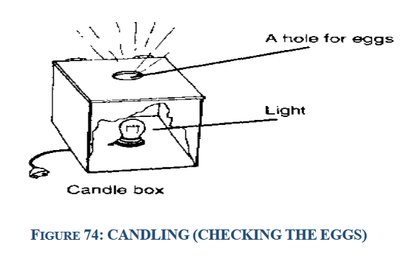
You will need to check eggs:
- Before putting them in the incubator
- 7 days later
- On day 18 of the incubation Period
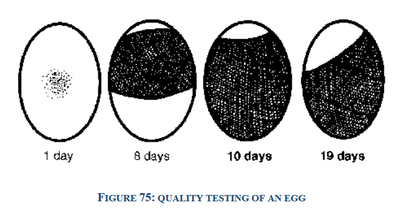
Brooder (For keeping very young birds)
If you buy young birds, or hatch them in an incubator, you will need to keep them in a brooder for a few weeks. You can buy a brooder or make your own. Brooders have a source of heat to replace the heat that the young would have from their mother. In the brooder, they are protected from animals and the weather.
A simple brooder is made from a heavy box or basket and a hurricane lamp (kerosene lamp) as the source of heat. A 1 metre square box will make a brooder for 25 baby birds. The lamp is surrounded with wire mesh to stop the birds from touching it. Troughs (containers) for feed and water must be placed in the brooder and the birds can be kept in it until they are 4 weeks old.
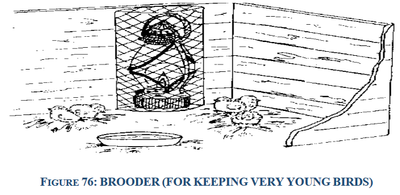
When birds have reached 4 weeks of age they do not need the heat of a lamp and are too big for the brooder. They should be placed in a fenced area (run) with a box covered with hay, straw, paper or cardboard. They can go into the box for warmth when they need it.
Water troughs (Containers)
Birds will drink a large amount of water and in hot weather can drink up to half a litre a day. Water troughs must be clean and birds should not be able to get inside them. You can buy troughs or cover a suitable container with wire. Water can also be given using a bottle held over a container.
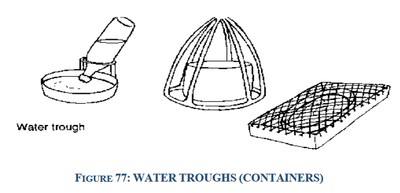
Ducks need enough water to cover their heads. They can splash water around which can cause problems. Placing the water container for ducks in a wood and wire mesh frame stops the birds reaching the muddy ground.
Feed Troughs (Containers)
Feed troughs can be bought or made from wood. The troughs must be big enough for all the birds to eat from it.A good trough for chickens is made from a wooden base with two perches on each side for the birds to stand on to feed. The height of the trough varies with the age of the birds. Across the top of the trough is placed a pole which will turn around if any bird tries to perch on it.
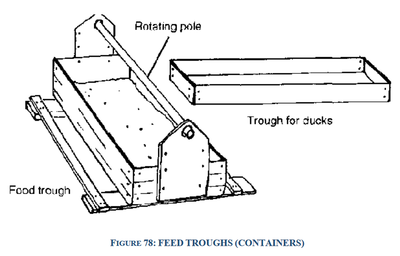
Ducks need shallow troughs or flat containers for feed.
Source : Pashu Sakhi Handbook
Last Modified : 5/15/2023
This topic provides information about feeding chic...
This topic provides information about the problems...
This topic provides information about the Internal...
This topic provides information about 20th Livesto...
